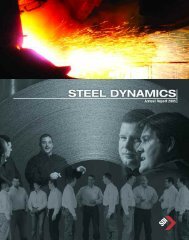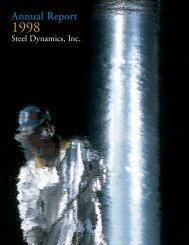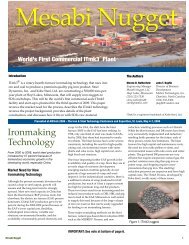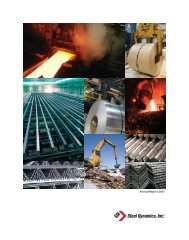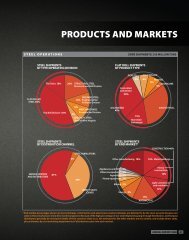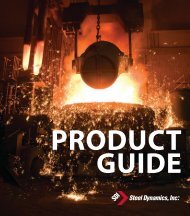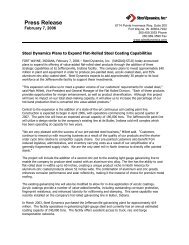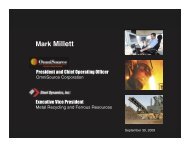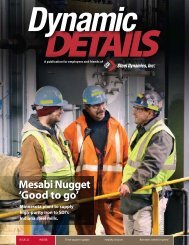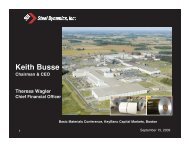MEsaBi NuggEt: - Steel Dynamics, Inc.
MEsaBi NuggEt: - Steel Dynamics, Inc.
MEsaBi NuggEt: - Steel Dynamics, Inc.
You also want an ePaper? Increase the reach of your titles
YUMPU automatically turns print PDFs into web optimized ePapers that Google loves.
DECEMBER 2009 • VOL. 98 NO. 12<br />
Mesabi Nugget:<br />
A Steady Presence for the Range<br />
p4
Mesabi Nugget:<br />
A Steady Presence for the Range<br />
Construction at the Mesabi Nugget project<br />
near the site of former taconite operations of<br />
LTV <strong>Steel</strong> Mining Co. near Hoyt Lakes, Minnesota,<br />
is virtually complete. Commissioning of<br />
numerous aspects of the many-faceted operation<br />
already has begun.<br />
The $260 million project, run by <strong>Steel</strong> <strong>Dynamics</strong>,<br />
Fort Wayne, Indiana, features the patented<br />
ITmk3 ironmaking process developed<br />
by Japanese steel giant, Kobe <strong>Steel</strong> Ltd. The<br />
new plant will employ a rotary hearth furnace<br />
to turn iron ore and pulverized coal into iron<br />
nuggets of similar quality to blast furnace pig<br />
iron. Although the ITmk3 process has been<br />
tested extensively in pilot plants, this will be<br />
the world’s first commercial iron nugget plant.<br />
The U.S. Department of Energy’s fact sheet<br />
on the process says that the technology will be<br />
able to complete reduction, melting and slag<br />
removal in only about 10 minutes. The ITmk3<br />
process is elegantly simple, it says, with a onestep<br />
furnace operation that requires less energy,<br />
capital, and operating cost than existing<br />
pig iron technology.<br />
“A lot has been done already,” said David<br />
Bednarz, vice president of iron resources with<br />
<strong>Steel</strong> <strong>Dynamics</strong>. In preparation for startup, coal<br />
is arriving from Hallett Dock in Duluth; the repulping<br />
facility is being commissioned, slurry<br />
is being processed then filtered and dried into<br />
green balls. Coal and limestone grinding is tak-<br />
ing place, as well. The raw materials are being<br />
metered/mixed and then turned into green<br />
balls, which are subsequently dried.<br />
Commissioning of the rotary hearth furnace<br />
equipment is also underway, Bednarz said. Refractory<br />
work on the rotary hearth furnace has<br />
begun and production should begin by the end<br />
of the year. The furnace, the world’s largest rotary<br />
hearth furnace, is 60 meters in diameter—<br />
about two-thirds the length of a football field.<br />
The finished iron nuggets, similar to pig iron<br />
in iron content but somewhat lower in carbon,<br />
will be 96% iron, with the rest carbon and silicon.<br />
Bednarz said specific chemistry has not<br />
been decided.<br />
He said that the advantage of nuggets over<br />
pig iron is they can be continuously charged,<br />
and the nugget size facilitates more efficient<br />
melting.<br />
The nuggets will go to <strong>Steel</strong> <strong>Dynamics</strong>’ Butler,<br />
Indiana, mini-mills via rail in 10- to 20-car<br />
blocks. The will be hauled by Canadian National<br />
to Chicago, then by Norfork Southern on to<br />
Butler. <strong>Steel</strong> <strong>Dynamics</strong> also is looking into the<br />
feasibility of shipping by water.<br />
Initially, Mesabi Nugget will use taconite<br />
concentrate from Northshore Mining in Silver<br />
Bay, and hematite concentrate from Magnetation<br />
<strong>Inc</strong>., which is reclaiming natural ore<br />
mine tailings basins near Keewatin on the<br />
Mesabi Range. The company has been stockpiling<br />
concentrate so it can be ready when<br />
the plant is ready to ramp up production.<br />
Mesabi Nugget eventually will mine its own<br />
taconite from an adjacent orebody, but work<br />
is not complete on an environmental impact<br />
statement. Environmental review has been<br />
slow, but they expect it to be completed in<br />
the fourth quarter of 2010. After the mine<br />
is operational, Mesabi Nugget intends to get<br />
its taconite exclusively from its own orebody.<br />
Construction began in 2007 and has continued<br />
through the recent downturn. The startup date<br />
originally planned for the third quarter of this<br />
year was pushed back to late 2009 because of<br />
the lower demand for iron in the short term.<br />
“We can shove back the capex on that and take<br />
operational losses,” said Keith Busse, chairman<br />
and CEO of <strong>Steel</strong> <strong>Dynamics</strong>. “Given our inventory<br />
position and the economy, there is no rush<br />
to get there,” he was quoted by American Metal<br />
Market (AMM) in April of this year.<br />
Although the project has had some roadblocks,<br />
it has chugged along regardless of the<br />
bad economy and has provided construction<br />
jobs on the Mesabi Range at a crucial time<br />
when many workers were hit hard by cutbacks<br />
at the mines. Industry observer, Peter Kakela, a<br />
professor at Michigan State University, told the<br />
Duluth News Tribune that he viewed the continued<br />
work as a sign of the project’s strength.<br />
This past summer, when there were more than<br />
4 SKILLINGS MINING REVIEW ı DECEMBER 2009
800 contractors on the job, the hours were long<br />
and the work was demanding. Bednarz put it<br />
this way: “There was heartache and frustration<br />
balanced by moments of brilliance.” His praise<br />
for and pride in the Mesabi Nugget workforce<br />
was abundant. He added that there is huge excitement<br />
about the project as it moves into its<br />
final ramping up stages.<br />
A one-step furnace operation that eliminates<br />
the need for a taconite plant, blast furnace,<br />
and coke ovens, Mesabi Nugget claims to<br />
be environmentally superior to conventional<br />
iron making because it can reduce energy consumption<br />
by 30% and carbon dioxide emissions<br />
by 21%. Also, because the nuggets will be<br />
96% iron, compared with the 66% iron taconite<br />
pellets, it reduces the amount of material to<br />
be transported to the steel plants, resulting in<br />
a high-quality, higher value iron product at a<br />
substantially lower cost.<br />
The nuggets will be fed into electric arc furnaces,<br />
producing flat-rolled steel at <strong>Steel</strong> <strong>Dynamics</strong>’<br />
Butler, Indiana, plant, replacing a portion<br />
of the scrap and imported pig iron.<br />
One industry observer noted that scrap has<br />
been the traditional material for electric arc<br />
furnaces and that the relatively high cost of<br />
scrap makes the Mesabi Nugget project viable.<br />
At full capacity, the plant will produce 500,000<br />
metric tons of iron nuggets annually and will<br />
have a permanent workforce of about 70.<br />
Mesabi Nugget was designed to eventually tri-<br />
IRON<br />
OXIDE<br />
MIXER<br />
REDUCTANT<br />
(COAL)<br />
SCREEN<br />
IRON<br />
NUGGET<br />
PELLETIZER<br />
SLAG<br />
DRYER<br />
ple in size if that kind of demand develops. The<br />
site is designed to accommodate this. Bednarz<br />
told Skillings that such an increase in size will<br />
depend on future cost structure and volume.<br />
He said the first year will tell a lot about what<br />
direction the project will take.<br />
According to a University of Minnesota-<br />
Duluth Bureau of Business and Economic<br />
Research study, the plant’s economic impact<br />
on Minnesota’s mining industry could nearly<br />
SCHEMATIC OF THE ITMK 3 PROCESS<br />
AIR<br />
HEAT<br />
RECOVERY<br />
SYSTEM<br />
ROTARY HEARTH<br />
FURNACE<br />
DUST<br />
COLLECTOR<br />
BURNER FUEL<br />
FLUE GAS<br />
MELTING<br />
REDUCING SEPARATING QUENCHING CRUSHING<br />
SLAG<br />
REMOVING SLAG<br />
IRON<br />
NUGGETS<br />
triple by 2013, a September Range Readiness<br />
Initiative article said.<br />
For Minnesota, the project opens up possibilities<br />
for taconite mines, which traditionally<br />
have sold their pellets to integrated steelmakers,<br />
to feed blast furnaces.<br />
Bednarz said, “It’s a pretty doggone exciting<br />
project.” He noted the project could be one of<br />
those major changes in modern industry.<br />
MESABI NUGGET<br />
PLANT AREA<br />
PROPOSED TAILINGS<br />
DISPOSAL AREA<br />
AREA 1 PIT<br />
AREA 2WX IN-PIT STOCKPILE<br />
CRUSHER AREA<br />
AREA 6NW PIT<br />
AREA 2WX PIT<br />
AREA 6 OVERBURDEN STOCKPILE<br />
AREA 6SW PIT<br />
AREA 6 PIT<br />
AREA 6 IN-PIT<br />
SOUTH STOCKIPILE<br />
AREA 2WX STOCKPILE<br />
AURORA<br />
POP. 1,350<br />
HOYT LAKES<br />
POP. 2,082<br />
DECEMBER 2009 ı SKILLINGS MINING REVIEW 5



